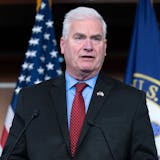University of South Carolina provost Joan Gabel nearly stole all of Minnesota's higher-education show last week with her barnstorming campaign for the University of Minnesota presidency, complete with visits to all five of the U's campuses.
That's fitting. A sole finalist for the CEO's position at what has rightly been called the most important public institution in the state deserves intense inspection. The Board of Regents is expected to act on her nomination on Tuesday.
Compelling though it was, I took my eyes off the Gabel charm offensive long enough last week to connect with two other new players in Minnesota higher-ed policymaking — state Rep. Connie Bernardy, DFL-New Brighton, and state Sen. Paul Anderson, R-Plymouth. They are the new chairs, respectively, of the House and Senate higher education committees — Bernardy replacing Rep. Bud Nornes, R-Fergus Falls, because the DFL has gained control of the state House; Anderson succeeding current Lt. Gov. Michelle Fischbach, who resigned from the Senate after the 2018 session.
According to the Legislature's time-honored committee pecking order, their new positions have midgrade status. The omnibus higher-education bills that Anderson, Bernardy and their committee contributors will write next year will be in the $3 billion to $3.5 billion range, neither the biggest nor the most politically potent of the session's lot.
But in terms of opportunity to influence this state's trajectory in the next several decades, Anderson and Bernardy are about to assume positions of considerable importance. As a pair of higher-ed elder statesmen, Robert Bruininks and Steven Rosenstone, argued on these pages on Dec. 2, Minnesota is going to need more of what higher education produces — both talent and knowledge — if this state is to stay prosperous during the next two demographically slow-growing decades.
And as the new state budget forecast shows, the Legislature will have to find ways to satisfy that dual imperative without a lot of new spending by taxpayers. The forecast $1.5 billion surplus isn't much in a $48 billion 2020-21 budget, especially since the surplus calculus includes little accounting for inflation in spending.
The trick for Anderson and Bernardy will be to make the most of what Minnesota has already built — a major knowledge-generating research university, a far-flung talent-producing state college and university system, and private colleges that shine in attracting promising students from around the country and seeing them through to graduation.
They'll need to help each system build its strengths while avoiding unnecessary duplication of effort. They'll need a more rigorous "commitment to focus." That's a 30-year-old U of M strategic slogan whose mention might make old higher-ed war wounds twinge. The two chairs should be willing to test whether "focus" is still a fighting word.



